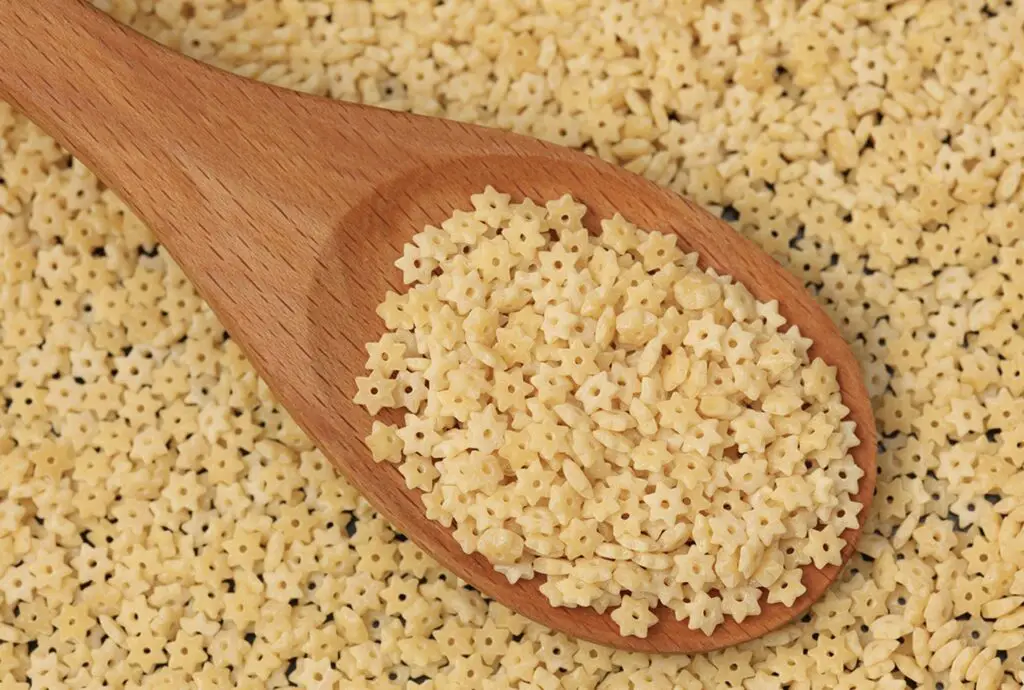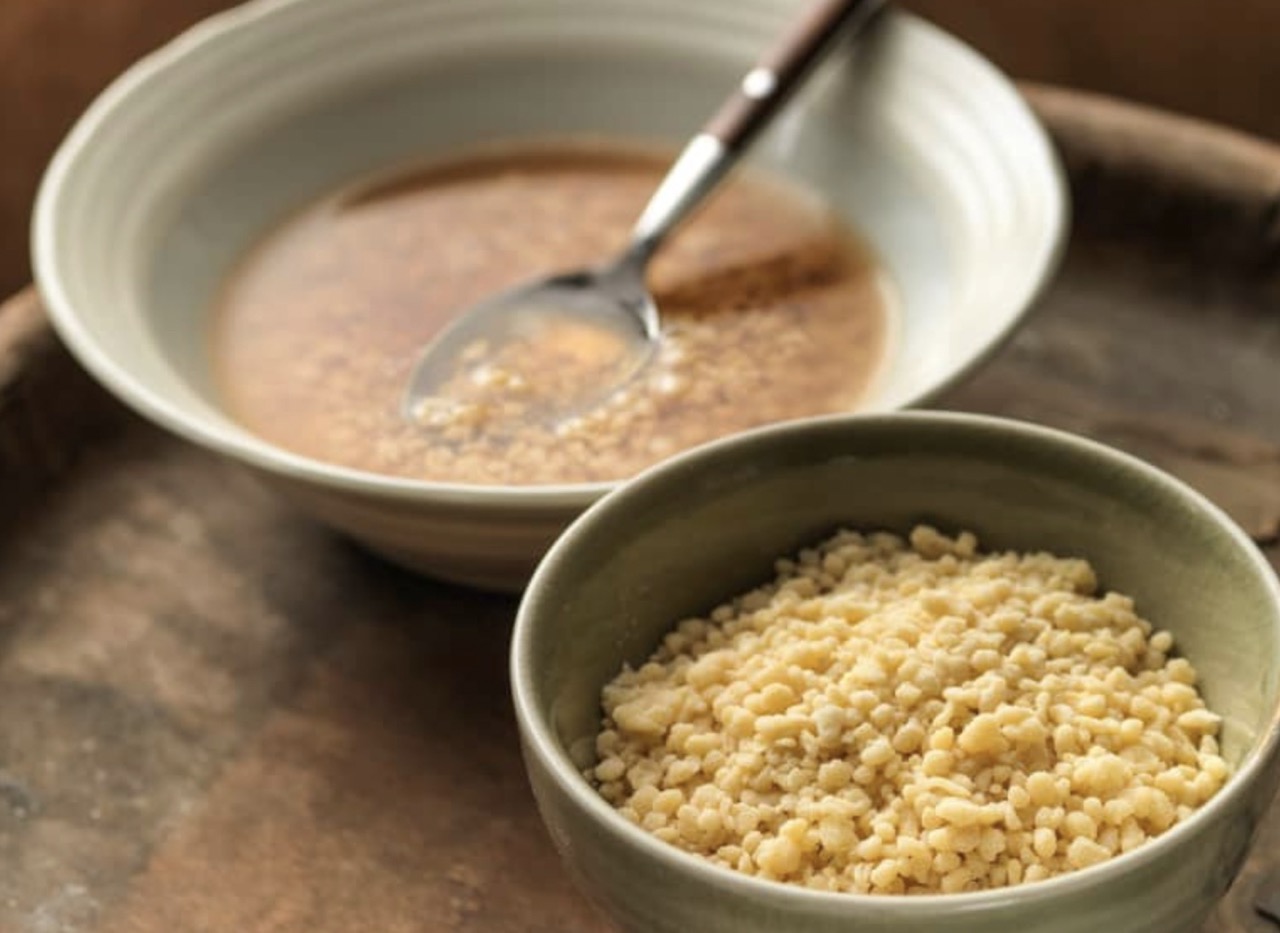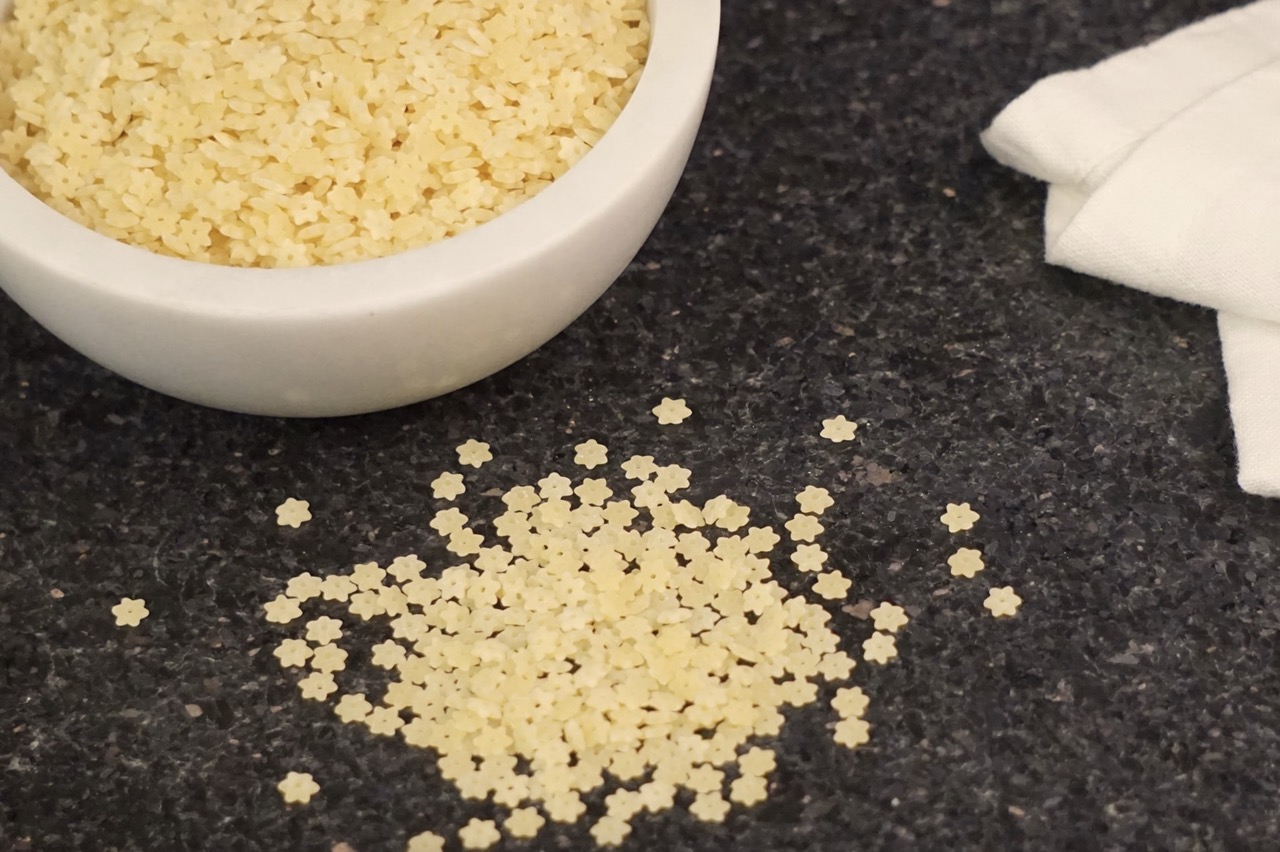Gluten-free pastina is a type of pasta that is made without wheat, barley, or rye. It is perfect for people who have celiac disease or gluten sensitivity. it can be enjoyed in a variety of ways, such as in soups, salads, or as a side dish.
What sets gluten-free pastina apart from regular pasta is that it is made from alternative grains, such as corn, rice, or quinoa. This means that it is safe for people who need to avoid gluten in their diet. Gluten-free pastina is also a great source of carbohydrates, which are essential for energy.
Key Takeaways
- Gluten-free pastina is a type of pasta made without wheat, barley, or rye, making it a safe option for people with celiac disease or gluten sensitivity.
- It is made from alternative grains like corn, rice, or quinoa and is a great source of carbohydrates.
- Gluten-free pastina can be enjoyed in a variety of ways and is a versatile addition to any meal.
What is Gluten Free Pastina
Gluten-free pastina is a type of small pasta made without wheat or gluten. It is an ideal option for those who are gluten intolerant, gluten-sensitive, or have celiac disease. The pasta is made using alternative grains like corn, rice, quinoa, and chickpeas, which are naturally gluten-free.
The texture of gluten-free pastina is similar to regular pasta, but it may have a slightly different flavor. It is available in a variety of shapes, including stars, shells, and spirals. Gluten-free pastina is a versatile ingredient that can be used in a variety of dishes, including soups, salads, and casseroles.
One of the main benefits of gluten-free pastina is that it is safe for people with celiac disease or gluten sensitivities to consume. Celiac disease is an autoimmune disorder that causes damage to the small intestine when gluten is consumed. Gluten sensitivity causes similar symptoms to celiac disease but does not cause damage to the small intestine.
Gluten-free pastina also provides a healthy alternative to traditional pasta. Many gluten-free pastas are made from whole grains, which are high in fiber and other nutrients. They can also be lower in calories and carbohydrates than traditional pasta. However, it is important to read the labels and check the nutritional information to ensure that the pasta is a healthy option.
Benefits of Gluten Free Pastina
Nutritional Value
Gluten-free pastina is made from alternative flours such as rice, corn, and potato flour. These flours are naturally gluten-free and provide a variety of nutrients that are not found in traditional wheat pasta. For example, rice flour is a good source of carbohydrates, protein, and fiber. Corn flour is rich in vitamin B6, iron, and magnesium. Potato flour is high in potassium, vitamin C, and vitamin B6.
Health Benefits
Gluten-free pastina is a great option for people who have celiac disease or gluten intolerance. These conditions can cause severe digestive problems and other health issues. By replacing traditional wheat pasta with gluten-free pastina, people with these conditions can avoid gluten and still enjoy a variety of pasta dishes.
In addition, gluten-free pastina can provide other health benefits. For example, it can help people maintain a healthy weight. Traditional pasta is often high in calories and carbohydrates, which can contribute to weight gain. Gluten-free pastina, on the other hand, is often lower in calories and carbohydrates, making it a good choice for people who are trying to lose weight or maintain a healthy weight.
Gluten-free pastina can also be a good source of fiber. Fiber is important for digestive health and can help prevent constipation, diarrhea, and other digestive problems. By including gluten-free pastina in their diet, people can increase their fiber intake and improve their digestive health.
Overall, gluten-free pastina provides a variety of nutritional and health benefits. By incorporating it into their diet, people can enjoy a variety of pasta dishes while also improving their health.
How to Cook Gluten Free Pastina
Cooking gluten-free pastina is a simple process that requires a few basic ingredients and some careful attention. Here are the steps to follow:
- Choose your pastina: There are many gluten-free pastina options available, including stelline, orzo, and pastina shells. Choose the type that you prefer and make sure it is labeled gluten-free.
- Boil water: Bring a large pot of salted water to a boil. You will need about 4 cups of water for every 1 cup of pastina.
- Add pastina: Once the water is boiling, add the pastina and stir gently. Cook the pastina for the amount of time specified on the package, usually 8-10 minutes.
- Test for doneness: To test if the pastina is cooked, remove a piece and taste it. It should be tender but still firm to the bite.
- Drain and rinse: Once the pastina is cooked, drain it in a colander and rinse it with cold water to stop the cooking process.
- Add toppings: Pastina can be served plain or with a variety of toppings. Some popular options include butter, grated Parmesan cheese, tomato sauce, or pesto.
- Serve immediately: Pastina is best served immediately after cooking. If you need to keep it warm, cover it with a lid or foil to prevent it from drying out.
By following these simple steps, you can enjoy delicious gluten-free pastina that is tender, flavorful, and perfect for any meal.
Popular Gluten Free Pastina Brands
When it comes to gluten-free pastina, there are some popular brands that are worth trying out. Here are a few options:
1. DeLallo
DeLallo is a well-known brand that offers a variety of gluten-free pastas, including pastina. Their pastina is made from a blend of corn and rice flour and has a smooth texture that makes it perfect for soups and broths.
2. The Sprouted Flour Co.
The Sprouted Flour Co. offers a unique gluten-free pastina made from sprouted brown rice flour. This pastina has a nutty flavor and a slightly chewy texture that sets it apart from other gluten-free pastas.
3. Jovial
Jovial is another popular brand that offers a range of gluten-free pastas, including pastina. Their pastina is made from organic brown rice and has a delicate, light flavor that pairs well with a variety of sauces and broths.
4. Le Veneziane
Le Veneziane is an Italian brand that specializes in gluten-free pasta. Their pastina is made from corn flour and has a slightly sweet flavor that works well with savory broths and soups.
5. Barilla
Barilla offers a gluten-free pastina made from a blend of corn and rice flour. This pastina has a smooth texture and a neutral flavor that makes it a versatile option for a variety of dishes.
Overall, there are many great options when it comes to gluten-free pastina brands. It’s worth trying out a few different brands to find the one that works best for your taste preferences and dietary needs.
Where to Buy Gluten Free Pastina
Finding gluten-free pastina can be a challenge, but it is becoming more widely available as demand for gluten-free products continues to rise. Here are some places to look for gluten-free pastina:
Online Retailers
Many online retailers offer a wide selection of gluten-free pastina. Amazon, for example, carries a variety of brands and shapes of gluten-free pastina, including Le Veneziane and Jovial. Some online retailers, like Thrive Market, specialize in natural and organic products and offer a selection of gluten-free pastina.
Specialty Grocery Stores
Specialty grocery stores like Whole Foods Market and Sprouts Farmers Market often carry a variety of gluten-free pastina. These stores may also carry lesser-known brands that offer gluten-free pastina in unique shapes or made from alternative grains.
Italian Specialty Stores
Italian specialty stores may carry gluten-free pastina made in Italy, where gluten-free products are more common. These stores may also offer a wider variety of shapes and sizes of gluten-free pastina than traditional grocery stores.
Online Gluten-Free Retailers
There are also online retailers that specialize in gluten-free products, like Gluten Free Mall and Gluten Free Palace. These retailers offer a wide variety of gluten-free pastina, including unique shapes and brands that may be harder to find in traditional grocery stores.
No matter where you choose to buy your gluten-free pastina, always check the label to ensure that it is certified gluten-free and made from safe ingredients.
Recipes Using Gluten Free Pastina
If you’re looking for some delicious recipes using gluten-free pastina, you’re in luck! There are plenty of options out there for breakfast, lunch, and dinner. Here are a few tasty recipes to try out:
Breakfast Recipes
- Pastina with Fried Egg: Cook the pastina according to the package instructions. In a separate pan, fry an egg to your liking. Serve the egg on top of the pastina and season with salt and pepper.
- Pastina Porridge: Cook the pastina in milk until it’s soft and creamy. Add in your favorite sweeteners and toppings, such as honey, berries, and nuts.
Lunch Recipes
- Pastina Salad: Cook the pastina and let it cool. Mix in chopped vegetables, such as cucumber, tomato, and bell pepper. Dress with olive oil and lemon juice and season with salt and pepper.
- Pastina Soup: Cook the pastina in chicken or vegetable broth. Add in chopped vegetables, such as carrots and celery, and season with herbs and spices.
Dinner Recipes
- Pastina with Meatballs: Cook the pastina according to the package instructions. In a separate pan, cook meatballs until they’re browned on the outside and cooked through on the inside. Serve the meatballs on top of the pastina and top with your favorite sauce.
- Pastina Casserole: Cook the pastina and mix in chopped vegetables, such as spinach and mushrooms. Add in cooked chicken or sausage and top with shredded cheese. Bake in the oven until the cheese is melted and bubbly.
These recipes are just a few examples of the many ways you can use gluten-free pastina in your cooking. Get creative and experiment with different ingredients and flavors to find your perfect dish!
Storing and Shelf Life of Gluten Free Pa
stina
Gluten-free pastina has a relatively long shelf life when stored properly. It is importa
nt to keep the pasta dry and away from moisture to prevent mold and bacteria growth. Here are some tips for storing gluten-free pastina:
- Store in a cool, dry place: Keep the pasta in a cool and dry place, away from direct sunlight and heat sources. A pantry or cupboard is a good option.
- Use airtight containers: Transfer the pasta to airtight containers, such as glass jars or plastic containers with tight-fitting lids. This will help to keep the pasta fresh and prevent it from absorbing moisture.
- Check for expiration dates: Always check the expiration date on the package before purchasing gluten-free pastina. Most brands have a shelf life of 1-2 years, but it can vary depending on the manufacturer.
- Freeze for long-term storage: If you want to store gluten-free pastina for longer than a year, consider freezing it. Transfer the pasta to a freezer-safe container or bag and store it in the freezer. Frozen gluten-free pastina can last up to 2-3 years.
It is important to note that the shelf life of gluten-free pastina can vary depending on the brand and the ingredients used. Always check the expiration date and store the pasta properly to ensure its freshness.
Potential Drawbacks of Gluten Free Pastina
While gluten-free pastina is a great alternative for those who are sensitive to gluten, there are some potential drawbacks to keep in mind.
Lack of Nutritional Value
Gluten-free pastina is often made with refined grains, which means it lacks the nutritional value of whole grains. Whole grains are an important source of fiber, vitamins, and minerals, and their absence in gluten-free pastina can lead to a less nutritious diet overall.
Higher Cost
Gluten-free pastina can be more expensive than traditional wheat-based pastina. This is because the ingredients used to make gluten-free products are often more expensive, and the production process can
be more complicated.
Texture and Taste Differences
Gluten-free pastina can have a different texture and taste compared to traditional pastina. This is because gluten plays an important role in the texture and structure of pasta. Gluten-free pastina can be m
ore fragile and may break apart more easily, and the taste can be different due to the use of alternative flours.
Potential Cross-Contamination
Cross-contamination can be a concern for those with celiac disease or severe gluten sensitivity. Even if the pastina itself is gluten-free, it may have been processed or packaged in a facility that also processes wheat-based products. This can lead to trace amounts of gluten in the final product, which can be enough to trigger a reaction in some individuals.
While there are some potential drawbacks to gluten
-free pastina, it can still be a great option for those who need to avoid gluten. By being aware of these potential issues and choosing high-quality gluten-free pastina, individuals can still enjoy a delicious and satisfying pasta dish without compromising their health.
Frequently Asked Questions
Does anyone make gluten-free pastina?
Yes, several brands offer gluten-free pastina options. Look for dedicated gluten-free pasta brands in your local grocery store or check specialty health food stores.
What is a gluten-free alternative to pastina?
Quinoa, rice, or corn-based pastas are excellent gluten-free alternatives to traditional wheat-based pastina. Explore the variety of gluten-free grains to find the one that suits your taste.
Is all Barilla pasta gluten-free?
No, not all Barilla pasta is gluten-free. Barilla does have a line of gluten-free pasta, clearly labeled as such. Make sure to check the packaging for the “gluten-free” designation if you’re looking for a gluten-free option.
What is a substitute for pastina pasta?
If you’re searching for a substitute for pastina pasta, consider orzo, small rice-shaped pasta, or tiny gluten-free pasta varieties. Each provides a similar texture and can be used in a variety of dishes as a substitute for traditional pastina.
What are some gluten-free alternatives to pastina?
There are many gluten-free alternatives to pastina, including quinoa, rice, corn, and buckwheat. You can also use gluten-free pasta made from chickpeas, lentils, or other legumes.
Are there any brands that make gluten-free pastina?
Yes, there are several brands that make gluten-free pastina, including DeLallo, Barilla, and Jovial. These brands offer a variety of gluten-free pastina shapes, such as stelline, ditalini, and acini de pepe.
What is the texture of gluten-free stelline pasta?
Gluten-free stelline pasta has a similar texture to traditional stelline pasta, but it may be slightly softer or more delicate. It is important to cook gluten-free stelline pasta according to the package instructions to ensure the best texture.
Can you make soup with gluten-free ditalini?
Yes, you can make soup with gluten-free ditalini pasta. Gluten-free ditalini pasta is a small, tube-shaped pasta that is perfect for adding to soups and stews. Be sure to cook the pasta separately and add it to the soup just before serving to prevent it from becoming mushy.
Is all Barilla pasta gluten-free?
No, not all Barilla pasta is gluten-free. Barilla offers a variety of gluten-free pasta options, including spaghetti, penne, and fusilli, but not all of their pasta products are gluten-free. It is important to check the label before purchasing any Barilla pasta product.
What are some gluten-free substitutes for acini de pepe pasta?
Some gluten-free substitutes for acini de pepe pasta include small pearl tapioca, quinoa, orzo made from rice or corn, and small-shaped gluten-free pasta made from chickpeas or lentils. These substitutes can be used in recipes that call for acini de pepe pasta, such as Italian wedding soup or fruit salad.
Conclusion
In conclusion, it is a delicious and versatile option for those who are gluten intolerant or have celiac disease. It can be made with a variety of broths and toppings, making it a customizable dish that can be adapted to suit different tastes.
When cooking gluten-free pastina, it is important to keep in mind that it may require more liquid than traditional pasta to achieve the desired texture. Adding a bit of the cooking liquid back into the pasta after draining can also help prevent it from drying out.
it can be enjoyed as a standalone dish or as a side to complement other dishes. It is a great option for those who are looking for a comforting and filling meal that is also gluten-free.
Overall, it is a great addition to any gluten-free diet and can be enjoyed by everyone, regardless of their dietary restrictions. With a little creativity and experimentation, it is possible to create a variety of delicious and satisfying gluten-free dishes.
Thank you for reading.
Savor the Goodness: Click for Recipes:
Crab stuffed Cheddar Bay Biscuit with a Lemon butter sauce
Sex in a Pan
Classic Southern Caramel Cake
Old Fashioned Stuffed Cabbage Rolls
Moist chocolate cake stuffed with strawberries and condensed milk
Milk Brioche
Lizzy cake
Broccoli and Cheese Stuffed Chicken Breast
Shrimp in a garlic Alfredo Sauce with Fettuccine
Fresh Blueberry Cheesecake with Homemade Crust
Classic Butter Cookies
Broccoli and Cheddar Cheese Bites
Best Scalloped Potatoes
Chocolate Chip Doughnuts
Lazy Day Oatmeal Cake
Join our community on social media!
Enjoyed this delicious recipe? Share the love with your friends and family by clicking the share button below. Good food is meant to be shared, and your culinary discoveries can brighten someone else’s day!



